Science Recap: 20 Promising Health Discoveries From the First Half of 2023
Find nothing but the latest breakthrough studies from 2023, summarized by experts and free of irrelevant dry papers.

Thousands of scientific studies are published each year. Yet, it is difficult to distinguish between what is significant and what is not.
To bring you only the most important health discoveries, we created Science Recap. Find the latest studies on nutrition, fitness, heart health, beauty, diabetes, and mental well-being.
Science Recap will provide you with reliable, scientifically supported information. Also, it will keep you up-to-date with advances that have yet to receive much attention.
The team of doctors, led by Dr. Edna Skopljak and Dr. Donika Vata, examined every study to ensure it brought real value to the medical community.
Each recap section concisely describes key findings, methodologies, perspectives, and implications. To broaden the scope, we also spoke with experts in relevant fields.
Nutrition and Weight Loss
#1 Night owls are more likely to be emotional eaters
Description
This study investigated whether being an “evening type” (ET), meaning a preference for staying late and waking up later, is associated with emotional eating behaviors. It involved 3,964 participants from four countries who completed questionnaires to assess their chronotype and dietary habits.
Researchers used objective measures to determine chronotype, making it more accurate than previous studies.
Results
People who are ETs tend to have more emotional eating behaviors, overeating, and food cravings than “morning types.”
ETs also made up a higher proportion of all emotional eaters (66.6% compared to 53.9% of morning types).
Later timing of dim-light melatonin onset in ETs was connected to more emotional eating behaviors. Disruptions in sleep-wake cycles may contribute to emotional cravings (for example, a loss of control as an obsession to eat food).
Perspectives and practical implications
People with an evening chronotype are more vulnerable to obesity and metabolic risk due to their emotional eating behaviors, and clinicians should consider this when addressing metabolic disorders.
This also highlights the need for personalized behavioral therapy for emotional eating in ETs and its consequences, such as guilt.
#2 Mediterranean diet reduces migraine frequency, duration, and severity
Description
The objective of this study was to see if following a Mediterranean diet was linked to fewer and less severe migraine headaches. The researchers asked 262 adults with migraines to complete a questionnaire about their diet and symptoms.
Results
People who ate a Mediterranean-style diet tended to have fewer and shorter migraine headaches and lower scores on two migraine impact and severity measures. This was especially true for women.
Perspectives and practical implications
Following a Mediterranean diet may be a helpful way to manage migraine headaches, which could be good news for people suffering from this condition.
#3 Siesta study: how sleep habits and eating patterns impact our metabolic health
Description
Researchers wanted to know if siestas (midday naps) contribute to obesity based on how long they last, and if lifestyle habits also play a role.
The study was conducted on 3,275 adults from a Mediterranean population who took siestas because it is culturally embedded. About 35% of the participants reported taking naps, with 16% taking long naps.
Results
Taking long naps (over 30 minutes) is associated with higher levels of obesity and metabolic syndrome. Short siesta takers were less likely to have high blood pressure.
Long siesta takers had a higher BMI, waist circumference, fasting glucose, and systolic and diastolic blood pressure. Smoking more cigarettes a day was also linked to a higher BMI.
Perspectives and practical implications
The study shows the importance of looking at siesta/nap duration and lifestyle factors to study metabolic health outcomes and determine the reasons for obesity.


Being aware of these findings may prompt patients to consider shorter siestas and pay closer attention to their lifestyle choices, such as the timing of meals and smoking habits. Gaining a better understanding of the ideal siesta length and its potential impact on health could guide public health policies and interventions.
#4 Adding walnuts to the usual diet can improve diet quality in the US
Description
The study aimed to see if adding 1 ounce of walnuts to the typical diets of people who don’t usually eat nuts can improve their diet quality and the intake of certain nutrients often lacking in American diets.
The researchers used data from an extensive survey that asked people what they ate and looked at how adding walnuts affected their nutrient intake and diet quality.
Results
Eating only 1 ounce or 28.35g of walnuts daily significantly improves the diet quality of people who don’t usually eat nuts, including kids and adults. This also helps in getting more nutrients that are often not consumed enough.
Researchers claim that 1 ounce of walnuts can:
- Reduce the percentage of adults with low magnesium intake from 69.6% to 52.0%
- Reduce the percentage of adults with low folate intake from 49.2% to 40.6%
- Increase the rate of adults with adequate potassium intake from 22.8% to 26.5%
- Improve overall diet quality significantly in children and adults: from 49.1% to 58.5% in children and from 52.4% to 59.2% in adults
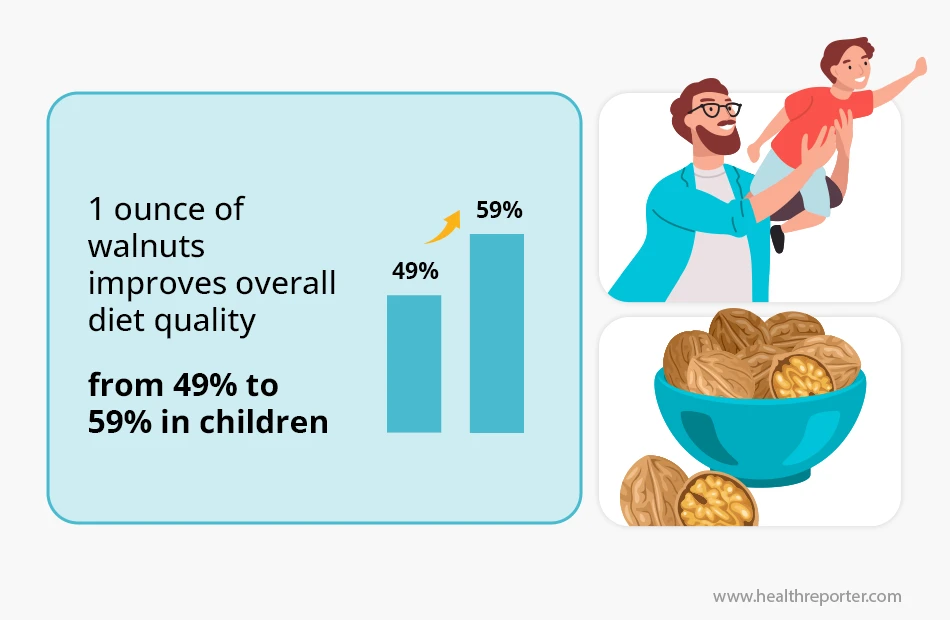
Perspectives and practical implications
Low intakes of calcium, potassium, fiber, and vitamin D in the US are considered public health concerns. Although dietary guidelines already recommend eating walnuts, which are rich in these nutrients, this study encourages people to make small dietary changes that can have a big impact on their health.
#5 ADF, CER, and TRE: which fasting diet is more effective for weight loss?
Description
This study looked at different ways of intermittent fasting (IF) and compared them to traditional caloric energy restriction (CER).
The researchers examined information from three databases to find weight loss and intermittent fasting studies. They specifically looked at the three most popular types of intermittent fasting: alternate-day fasting (ADF), the 5:2 diet, and time-restricted eating (TRE).
Later, they used a type of statistical analysis called random effect network analysis to compare how effective each intermittent fasting was for weight loss. The findings were presented as a weighted average of how much weight people lost.
Results
The study found that alternate-day fasting is the most effective among different fasting methods for weight loss, followed by a 5:2 diet or time-restricted eating. This comparison has never been done before in a meta-analysis.
In numbers, alternate-day fasting showed the highest weight loss ranging from 0.77% to 12.97% over 3–26 weeks. The 5:2 diet produced weight loss ranging from 1.7% to 7.97%, whereas time-restricted eating ranged from 0.95% to 8.60%.
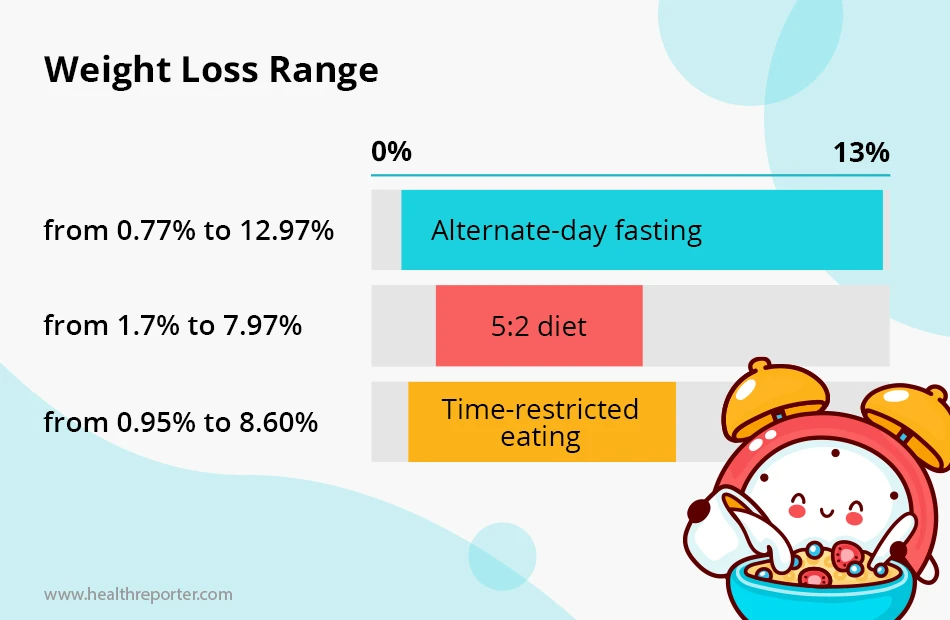
There were differences between the studies used in this analysis, which might be due to differences in the people studied, how the studies were designed, and how long they lasted.
Overall, the findings suggest that all three IF regimens are effective for weight loss and might be considered alternative strategies to CER for weight management.
Perspectives and practical implications
Those who want to lose weight through fasting should use alternate-day fasting (ADF) for the most effective results. Naturally, it should be tailored to the individual’s health.


The possible effects of implementing intermittent fasting as an alternative strategy to continuous energy restriction for weight loss and weight management on patients and their well-being could include the following:
Personalized weight loss approach
Tailoring IF regimens to an individual’s specific needs and acceptance allow for a more personalized approach to weight loss. This could lead to better adherence, increased motivation, and successful weight loss outcomes.
Improved metabolic health
IF regimens have various metabolic benefits, such as improved insulin sensitivity and fat turnover. These benefits could contribute to better health and well-being for patients following these dietary strategies.
Enhanced dietary flexibility
IF regimens may provide greater dietary flexibility compared to CER, making them more attractive and easier to adhere to for some individuals. This leads to better long-term weight management and improved well-being.
However, there are some concerns and drawbacks to consider. Over time, adherence to IF regimens declines, which affects long-term weight loss.
#6 Alcohol type matters for urate levels
Description
The study aimed to determine whether there were differences in the connection between urate levels and alcohol consumption. This included traditional Japanese drinks when standardized for the ethanol content.
High urate levels lead to hyperuricemia, which causes gout and kidney stones. Also, high urate levels are linked to an increased risk of developing heart disease and diabetes.
The researchers analyzed data from medical checkups of 78,153 Japanese participants.
Results
Even after standardizing for ethanol content, the association between serum urate levels and alcohol intake differed across different alcoholic beverages.
Beer consumption was consistently linked to higher urate levels, while sake was not. The association between serum urate levels and beer consumption was approximately 2–5 times higher than with sake.
Perspectives and practical implications
Both patients and medical professionals should consider alcoholic beverage type and ethanol content as a factor contributing to high urate levels.
#7 The impact of ultra-processed foods on cognitive decline: new evidence
Description
The researchers wondered if eating a lot of ultra-processed foods could cause cognitive decline when your thinking and memory skills deteriorate. They followed more than 10,000 adults for about 8 years, asking them about their diets and giving them tests to check their cognitive function.
Results
People who ate more than 19.9% of their daily calories from ultra-processed foods experienced a 28% faster cognitive decline.

Perspectives and practical implications
This new study supports evidence that eating less ultra-processed foods will help keep your brain healthy.
Fitness
#8 Fitness boosts memory performance in depression
Description
The study aimed to see if being physically fit could help protect against working memory problems in major depressive disorder (MDD).
Researchers tested 111 people with MDD and 56 healthy people by asking them to do a memory task while getting a brain scan. They also tested the physical fitness of 106 people with major depressive disorder using an exercise test on a bike.
Results
The study found that physical fitness was linked to better brain activity during a working memory task in MDD patients. It boosts blood flow and oxygen delivery to the brain, improving brain activity and cognitive performance.
Perspectives and practical implications
Fitness may protect against memory problems in MDD. The findings of this study may inform the development of physical exercise interventions for those with major depressive disorder. Healthcare professionals could recommend physical exercise as a complementary treatment for such patients.
#9 How physical fitness and social life affect work ability in middle-aged and older adults
Description
The study aimed to see how modifiable lifestyle factors, like physical fitness, cognitive functions, and social life, affect work ability (WA) in middle-aged and older employees. The researchers used the Work Ability Index survey and analyzed the data using statistical methods.
Results
The study found that having an active social life outside work was important for WA in both age groups. Physical fitness significantly affected WA only in middle-aged adults, and cognitive functions did not significantly influence WA in either group.
In older adults, physical fitness correlated with cognitive functions. In middle-aged adults, cognitive functions were marginally connected with social life.
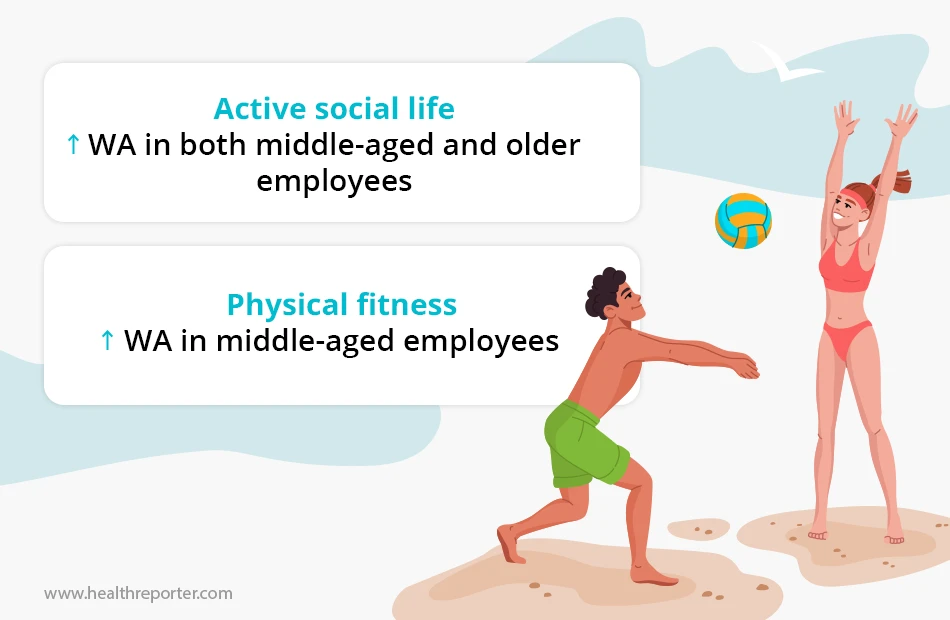
Perspectives and practical implications
The study’s results can help employers understand how to promote WA effectively in different age groups.
#10 Mandatory after-school step tracker apps boost adolescent health
Description
Researchers looked at whether using step-tracking apps on mobile phones after school for 10 weeks could improve the health of adolescents. The study examined 400 teenagers from two public schools in Spain. The researchers measured their body composition, how much they exercised, whether they followed a Mediterranean diet, and how physically fit they were.
Results
Compulsory step tracker app use led to more physical activity and significantly better body composition in the teenagers who used them compared to those who didn’t.
Perspectives and practical implications
Using step tracker apps could be a good way to help teenagers be more active and healthy, especially since many schools don’t have enough physical education time. The apps should be used outside school hours to make this effective because they aren’t designed for use during class.


While the intention is good, transferring responsibility for maintaining good health to mandatory compliance with a step tracker app needs to be revised. Step tracker apps are great if they support a person’s desire to increase their physical activity and provide a means to keep themselves accountable, but not so great if they are mandatory. Engaging in physical activity that is enjoyable and driven by choice is much more likely to be sustainable.
#11 Body-weight HIIT wins over running HIIT for teen fitness and muscle health
Description
This study examined two exercise programs: running-based high-intensity and body weight-based high-intensity interval training. The goal was to see which exercise improved teenagers’ physical fitness.
Researchers divided students from three schools into R-HIIT (running-based), B-HIIT (body-weight-based), and a control group. For 12 weeks, the R-HIIT and B-HIIT groups exercised twice a week. Statistical analysis was used to compare their physical fitness before and after.
Results
The body-weight-based group improved cardiorespiratory fitness and muscle endurance more effectively than the running-based group.
Perspectives and practical implications
This study proves that body-weight-based exercises can effectively replace traditional cardio exercises like running.
Heart Health
#12 A decade of cardiovascular risk factors in US adults 20–44 years old across ethnicities
Description
This study examined whether the prevalence of cardiovascular risk factors among young adults (aged 20 to 44 years) in the United States changed between 2009 and March 2020. The researchers analyzed data from 12,924 adults by sex, race, and ethnicity using cross-sectional analysis.
Results
The study found that from 2009 to March 2020, the prevalence of diabetes increased from 3.0% to 4.1% (an increase of 1.1%), and the prevalence of obesity increased from 32.7% to 40.9% (a rise of 8.2%).
Black, Hispanic, and Mexican American individuals had the highest rates of cardiovascular risk factors:
- Hypertension ranged from 29.7% to 44.9%
- Obesity ranged from 46.7% to 54.6%
- Diabetes ranged from 14.9% to 25.8%
- Smoking ranged from 11.1% to 18.3%
Control of blood pressure and glycemic control didn’t improve significantly.

Perspectives and practical implications
The significance of this study lies in its large analyzed time (2009 to 2020) and sample size (nearly 13,000). A long observation period provides a reliable perspective on cardiovascular risk factors, diabetes, and obesity over time.


The contrasting changes in the prevalence of hypertension (no improvement) versus the prevalence of hyperlipidemia (significantly decreased) are reasonable notice. Hypertension is sustained high blood pressure. Hyperlipidemia means “high lipids” and includes cholesterol and triglycerides.
Hypertension and hyperlipidemia are now regularly (and often successfully) treated with medications – it is interesting that hypertension rates have remained steady while hyperlipidemia rates have declined. Part of this could be the tight association between obesity and hypertension (as obesity rates have also risen).
Racial and ethnic patterns are also of interest. Cardiovascular anatomy and physiology are identical across races (race and ethnicity have minimal biological basis). As such, these data seem to speak to continued healthcare access and quality disparities within the United States that disproportionately affect black and Hispanic populations.
Beauty
#13 New herbal combination for anti-skin aging: Centella asiatica and Phyllanthus emblica
Description
This study aimed to develop a natural, safe, and effective anti-skin aging emulsion using an optimized multi-herbal combination of Centella asiatica (CA), Momordica cochinchinensis (MA), and Phyllanthus emblica (EM).
The concentration of each extract varied from 0% to 3%, and the best combination was determined based on the antioxidant potential of each extract.
The developed emulsion was evaluated for its physical characteristics and biological properties, and a clinical study was conducted to test its efficacy and safety in improving skin hydration, elasticity, and wrinkles.
Results
The results showed that the optimized combination of 3% Phyllanthus emblica and 3% Centella asiatica provided the highest antioxidant potential. The developed emulsion was stable, and no skin irritation was reported among the volunteers. After 60 days of application, significant improvements in skin hydration, elasticity, and wrinkles were observed in the test group.
Perspectives and practical implications
A new optimized multi-herbal combination can be used to develop an effective anti-skin aging formulation with potential implications in the natural cosmetics market.


Combining these two herbal extracts to prevent skin aging is a fantastic duo. Both have been studied and showed excellent results in overall skin health.
This paper is setting a starting point to understand how both herbal extracts work together to create anti-inflammatory therapy, collagen stimulation, increase fibroblast production, and, consequently, aesthetically appealing skin with fewer wrinkles.
Even though the action of both herbs is known, it is vital to clarify the maximum doses unrelated to side effects and if the increase in their amount in the topical skin lotion could also increase the benefits.
This study will impact the beauty industry in a good way. Nowadays, it is often focused on just popular ingredients to create temporary results and give patients the feeling of more hydrated skin. But proper cellular and peptide stimulation is needed to have natural and long-lasting results in patients with mild signs of aging and for those looking to prevent the decline of their skin health.
The results from this combination are mild, and many patients look forward to instant and drastic results. The patient needs a constant and regular application of this combination to get the expected natural results and diminish wrinkles.
#14 Fasting-mimicking diet improves skin hydration and texture
Description
The study examined how a five-day fasting-mimicking diet (FMD), given once a month for three months, affected the facial skin of 45 healthy women between the ages of 35 and 60. The researchers compared a group that followed the FMD with a group that followed their usual diet. They used self-reported data on several aspects of skin health and psychological well-being.
Results
The FMD group had a significant increase in skin hydration and skin texture. Those who maintained their usual diet had an increase in skin roughness. Also, FMD had positive effects on mood and self-perception.
Perspectives and practical implications
A fasting-mimicking diet may benefit those who want to improve skin health and psychological well-being.
#15 Sugar-sweetened beverages increase male hair loss risk
Description
This study investigated the association between consuming sugar-sweetened beverages (SSB) and male pattern hair loss (MPHL) in young men. The study was conducted in China from January to April 2022 and involved 1,951 young men aged 18–45. The researchers used a self-reported online survey to collect data.
Results
High sugar-sweetened beverage consumption was associated with a higher risk of male pattern hair loss (even after adjusting for sociodemographic, hair status, dietary intake, lifestyle, and psychological factors).
Only 11.8% of participants did not consume SSBs in the last month, and the average intake frequency was 11.15 times per week, showing a high sugar-sweetened beverage intake in the young population.
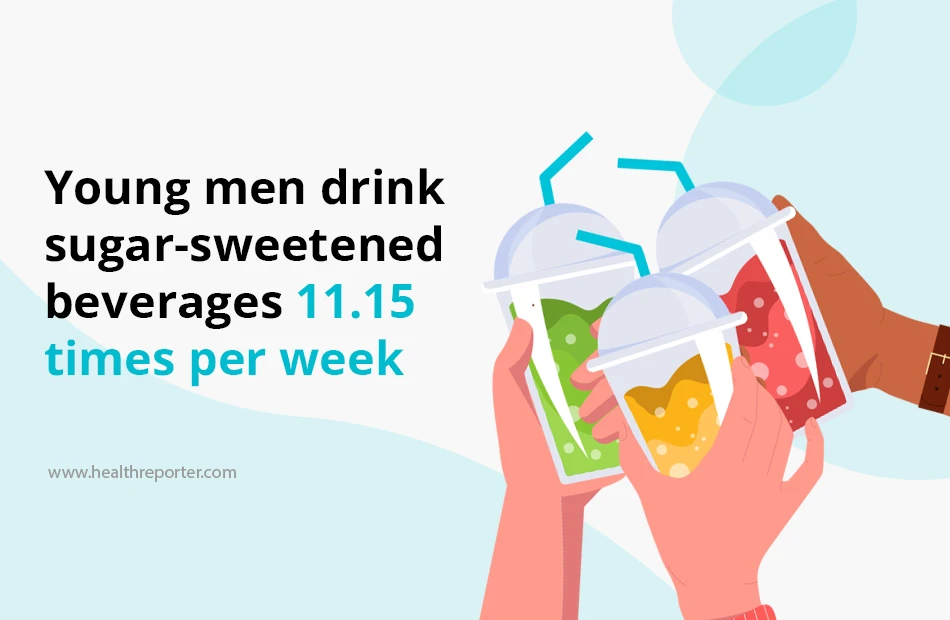
Perspectives and practical implications
The high intake of SSBs in the young population is due to a lack of awareness of their harmful effects. This study supports the reduction of sugar-sweetened beverages among young people to minimize negative health outcomes such as MPHL.
#16 Insulin resistance can be the cause of your acne
Description
The study looked at how insulin resistance relates to acne vulgaris. Researchers compared 43 acne patients with 48 healthy people of the same age and gender. They measured C-peptide and triglyceride-glucose (TyG) index levels and used the Global Acne Grading System to rate the severity of acne.
Results
81% and 67% of people with acne, respectively, had insulin resistance, as indicated by their C-peptide and TyG index levels (both markers of insulin sensitivity). The more severe the acne, the higher the levels of these markers. Thus, insulin resistance and high insulin levels may play a role in causing and exacerbating acne.
Perspectives and practical implications
These findings have potential implications for the health and hair industry, as they suggest that dietary and lifestyle interventions improve insulin sensitivity and benefit acne management.


Even though this study was done with a small sample and many other variables must be considered, the results set a good base to continue studying what many people with acne notice, and there needs to be more research done.
For many years acne vulgaris has been attributed to hormonal changes and hyperreactive skin glands, but having scientific proof that dietary and lifestyle changes may improve acne would positively affect patients’ well-being.
The human body is constituted by complex mechanisms that need a synchronized flow to be healthy. A balanced, healthy body will show healthy skin, hair, and nails. Topical treatment alone might not be enough to treat this type of condition.
Diabetes
#17 Coffee, tea, and low-fat milk reduce mortality risk in type 2 diabetes patients
Description
The study’s objective was to see how drinking different beverages affected the risk of death and cardiovascular disease in adults with T2D. Researchers used data from two studies and followed 15,486 participants over an average of 18.5 years. They collected data on beverage consumption using a validated food frequency questionnaire.
Results
Consuming high amounts of sugar-sweetened beverages (SSBs) was associated with a higher mortality risk and cardiovascular disease. However, drinking coffee, tea, plain water, and low-fat milk were connected to a lower mortality risk and cardiovascular disease. Artificially sweetened beverages and fruit juice did not significantly impact mortality or cardiovascular disease.
Perspectives and practical implications
Choosing healthy beverages like coffee, tea, plain water, and low-fat milk over sugary drinks will help reduce the risk of cardiovascular disease and premature death in people with type 2 diabetes. This has important implications for developing effective strategies to prevent and manage chronic conditions.
#18 Low-carb, high-fat diet shows greater improvements in type 2 diabetes and weight loss compared to a high-carb, low-fat diet
Description
The researchers wanted to see if a high-fat, low-carb diet (LCHF) could help people with type 2 diabetes and nonalcoholic fatty liver disease. They compared this diet to a high-carb, low-fat diet (T2DM) for 6 months, with a follow-up after 3 months.
Results
People on the low-carb, high-fat diet had better control of their blood sugar and lost more weight than those on the high-carb, low-fat diet. Both diets improved cholesterol levels, and the LCHF diet did not worsen fatty liver disease.
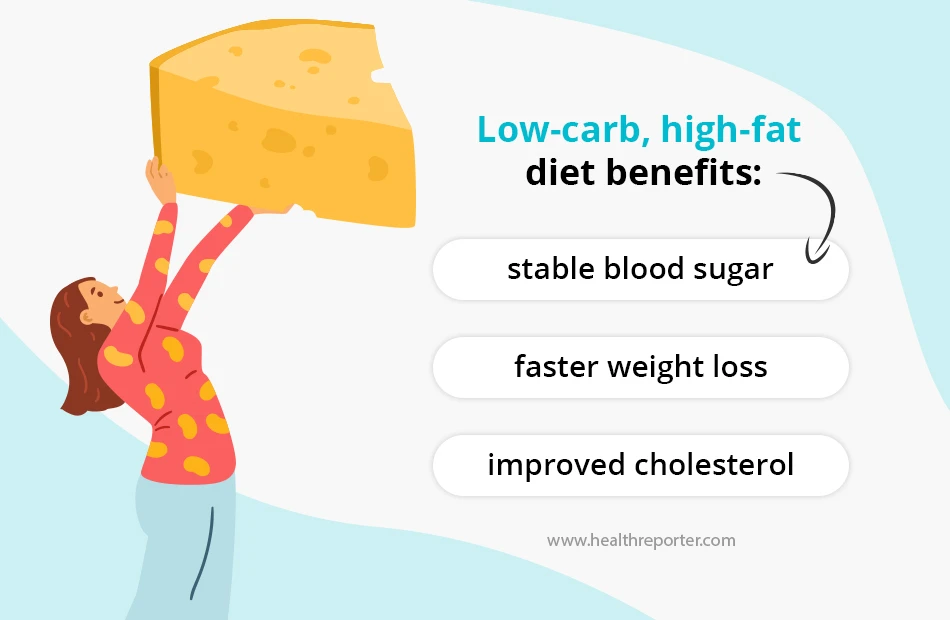
Perspectives and practical implications
The study shows that the LCHF diet can be a good treatment for people with type 2 diabetes.


This research makes sense to me. Diabetes is an insulin resistance disease. Insulin is an anabolic hormone; carbohydrates trigger it to store carbohydrates in the body as fat. A low-carb, high-fat diet will be more satiating (so the person will eat fewer calories overall), will not trigger as big of an insulin response, and will trigger the oxidation of stored fat to blood glucose (since the ingested glucose/carbohydrates will be low). Given our carb-heavy society, I speculate that the changes were not sustained after 3 months due to the difficulty of maintaining such a diet.
Mental Health
#19 Community gardening improves health and reduces stress in US adults
Description
This study looked at how community gardening affects the diet, physical activity, and psychological well-being of adults of different ages, ethnicities, and socioeconomic backgrounds. Researchers recruited people from waiting lists for community gardens in Denver and Aurora, randomly assigning them to receive a garden plot or remain on the waiting list. They also collected data through diet recalls, surveys, and measurements.
Results
The results showed that community gardening interventions increased fiber intake and physical activity. They also reduced chronic stress, anxiety, cancer risk, and chronic diseases.
However, it did not significantly change body measurements, healthy eating habits, or sedentary time.

Perspectives and practical implications
This was the first study to explore the impact of community gardening on health factors in urban adults. It provides evidence that community gardening can be a practical part of community-based strategies to improve health and well-being and reduce the risk of cancer and chronic diseases.
#20 Women with hormonal contraception-related depression are more vulnerable to postpartum depression
Description
The study aimed to find out if women who experienced depression associated with the use of hormonal contraception were more likely to develop postpartum depression (PPD) than those who had depression not linked to hormonal contraception.
Researchers examined the health records of 188,648 women who had their first child in Denmark between January 1, 1996, and June 30, 2017.
Results
Women who had depression associated with the use of hormonal contraception had a 42% higher risk of postpartum depression (PPD) than women who had a history of depression not linked to hormonal contraception.

Perspectives and practical implications
A woman’s history of depression associated with hormonal contraception can be a way to identify risks for developing postpartum depression. Those more sensitive to hormonal changes are also more likely to experience PPD.
Conclusion
The latest scientific studies on nutrition, fitness, heart health, beauty, diabetes, and mental well-being have shown areas where our health can be improved.
We’ve learned that the Mediterranean diet reduces migraines, becoming a natural way to manage them. Alternate-day fasting has shown promise for weight loss, providing an effective strategy for those looking to shed extra pounds.
Fitness can boost memory performance and improve work ability, especially as we age. Engaging in nature and community-based activities has been found to improve health and reduce stress.
Low-carb, high-fat diets help control diabetes and lose weight, offering alternative approaches. Coffee, tea, and low-fat milk reduce mortality risk in T2D patients, saving lives through simple dietary changes.
However, it’s not enough to know these findings. It’s a must to apply them wisely.
Putting these studies into practice will help make our lives better. Science has transformed the health industry in amazing ways, giving us new solutions to prevent diseases, treat them, and just be healthier.

















































 Select your language:
Select your language: 







